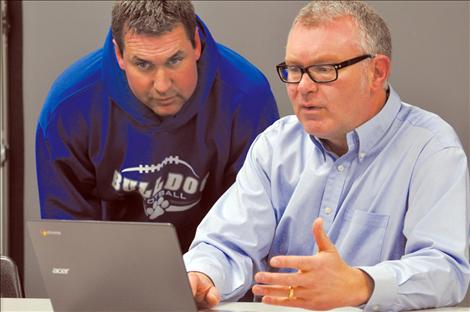A tale of two technology policies
Hey savvy news reader! Thanks for choosing local.
You are now reading
1 of 3 free articles.
LAKE COUNTY — The proliferation of technology has greatly expanded the limits of education, but also left two school districts grappling last week with questions about liability, boundaries, and ways to make sure the Internet is used responsibly instead of mismanaged by teens that might not fully understand the long-lasting consequences of their actions in a virtual world.
In discussion that saw no action, the Charlo board weighed the possibility of making an already restrictive cell phone policy more stringent, while the St. Ignatius board heard of the potentially positive effects of making its policies less stringent.
“Do we need to move further into a more stricter policy?” Charlo Board Chairman Shane Reum asked. The district already prohibits cell phone usage except during the lunch hour, when students in grades 9-12 can have the devices out when they are outside of the school. Students are required to turn cell phones over to chaperones on school trips, and are permitted to access the devices when they need to call for a ride home from the trip, Charlo Superintendent Thom Peck explained.
“I think we have one of the stricter policies,” Charlo Principal Steve Love said. “Kids will move in here and look at me like ‘what do you mean we can’t have our cell phone?’”
The policy helps limit the school’s liability in the case of any unauthorized photographs, but as tablets, Ipads, Kindles, and other devices come equipped with cameras, an entirely new generation of technology could potentially lead to unauthorized photography.
“It ain’t just this (anymore),” Reum said as he held up his cell phone and asked if the district needed to consider limiting the use of additional devices. “We allow iPads or iPods to watch movies, but that iPad or iPod can do more than this (phone) can do.”
Love said some events, like state tournaments or national conferences, are places where it is better for students to have their devices because they might be spread across several different buildings away from the coach. The ability to watch movies or listen to music can also make a long drive more bearable, Love said. Other drives to nearby districts might be too short for there to be much of an argument for the devices to be used.
“It’s such a fine balancing act,” Love said.
Difficulty in enforcing the school’s policy usually hits in waves.
“It goes in streaks,” Love said. “That day, for whatever reason, I had junior high and high school teachers bringing them in. It was like they all had a drink of something in their coffee and all of them had their iPods, their cell phones out. I had four or five that day. Then we’ll go three or four weeks (without incident).”
Peck said he believes the district should revisit its policy in the future.
“We’re not going to keep you away from technology,” Peck said. “We want to make sure you are using it in a responsible way in a school setting.”
Some schools in Bozeman have implemented procedures where students use their mobile devices to check in for attendance, Peck said.
It was in this direction that discussion about St. Ignatius District’s device policy trended, a night after Charlo’s meeting.
Technology coordinator Matthew Lyon listed a “bring your own device” policy as a possible future move the district could take in expanding access to online educational tools. Roughly half of the staff’s computers are at a tipping point where they will soon need to be replaced, Lyon said. The middle school computer lab and vocational lab computers also need to be upgraded or replaced. The district could probably function well with a fleet of a thousand $200 Google Chromebooks, according to Lyon. Even then, questions about outside devices remain.
Currently, Mission has an open network where anyone with a device that has mobile capability can connect to the school’s internet without a password. This is partly because the school also functions as a community library that promotes open access, Superintendent Bob Lewandowski said. A recent survey by Lyon revealed 63 percent of students in grades 7 through 11 used a device for schoolwork. Only eight percent of the students responded that they were unlikely to ever own a device with Internet capability.
On a recent day when the school’s network was slow, Lyon and Lewandowski took a trip down the school’s hallways to see what might be causing the sluggish speeds. They walked into a classroom where eight or nine students were streaming video and using tablets.
“It was like a whole computer lab in the room,” Lyon said. “They had just finished their semester tests. Some kids had tablets and phones. It was a whole different field we didn’t know about.”
Software to track usage of district computers versus outside devices is available and useful in rationing the amount of bandwith going to those devices, Lyon said. The district does not have that software currently.
Open access and “bring your own device” policies prompt questions about what is and isn’t acceptable. How does the district feel about use of social media on its networks? What constitutes acceptable use and what doesn’t? Can the school be held liable for content proliferated through its open network?
“The world’s changing,” Lyon said. “Kids are bringing in stuff in their own pocket.”
Lyon suggested the board jump ahead of the game in drafting policy.
“Where do we see ourselves going? Do we want to be leaders in this field that the standards of other schools are measured by? Or do we want to be constantly playing catch up?” Lyon asked.

















